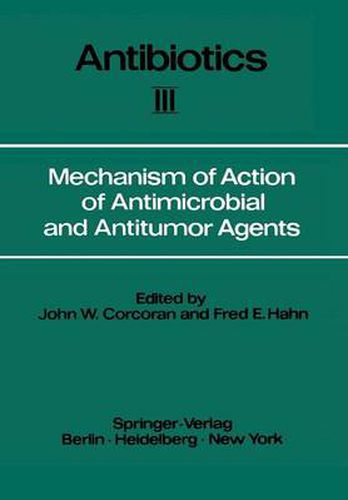Readings Newsletter
Become a Readings Member to make your shopping experience even easier.
Sign in or sign up for free!
You’re not far away from qualifying for FREE standard shipping within Australia
You’ve qualified for FREE standard shipping within Australia
The cart is loading…






This title is printed to order. This book may have been self-published. If so, we cannot guarantee the quality of the content. In the main most books will have gone through the editing process however some may not. We therefore suggest that you be aware of this before ordering this book. If in doubt check either the author or publisher’s details as we are unable to accept any returns unless they are faulty. Please contact us if you have any questions.
This volume is the third in the series devoted to Antibiotics initiated by Springer Verlag in 1967. The first two volumes were devoted to the Mode of Action of Antibiotics and Biogenesis, respectively and were received graciously. During the intervening years these two works have been used often by research workers and students alike and have been quoted extensively. Although a number of other excellent treatises on antibiotics have appeared, the Springer series has set a standard for thoroughness and quality that meets the need of the scientific community. It is against this background that the present Editors set about the preparation of a third volume in the Series on Antibiotics. Since the appearance of Volume I, also dealing with Mechanism of Action, tremendous strides have been made in the depth and breadth of our knowledge of molecular biology, microbial chemistry and molecular pharmacology and of their direct application to studies on the mode of action of drugs. The field of molecular biology itself was in its relative infancy during the preceding decade and the unique role played by many anti biotics in the development of our understanding of nucleic acid synthesis and function and its relationship to protein synthesis and cell physiology has led rapidly to a very precise, understanding of how many of these same antibiotics inhibit susceptible cells.
$9.00 standard shipping within Australia
FREE standard shipping within Australia for orders over $100.00
Express & International shipping calculated at checkout
Stock availability can be subject to change without notice. We recommend calling the shop or contacting our online team to check availability of low stock items. Please see our Shopping Online page for more details.
This title is printed to order. This book may have been self-published. If so, we cannot guarantee the quality of the content. In the main most books will have gone through the editing process however some may not. We therefore suggest that you be aware of this before ordering this book. If in doubt check either the author or publisher’s details as we are unable to accept any returns unless they are faulty. Please contact us if you have any questions.
This volume is the third in the series devoted to Antibiotics initiated by Springer Verlag in 1967. The first two volumes were devoted to the Mode of Action of Antibiotics and Biogenesis, respectively and were received graciously. During the intervening years these two works have been used often by research workers and students alike and have been quoted extensively. Although a number of other excellent treatises on antibiotics have appeared, the Springer series has set a standard for thoroughness and quality that meets the need of the scientific community. It is against this background that the present Editors set about the preparation of a third volume in the Series on Antibiotics. Since the appearance of Volume I, also dealing with Mechanism of Action, tremendous strides have been made in the depth and breadth of our knowledge of molecular biology, microbial chemistry and molecular pharmacology and of their direct application to studies on the mode of action of drugs. The field of molecular biology itself was in its relative infancy during the preceding decade and the unique role played by many anti biotics in the development of our understanding of nucleic acid synthesis and function and its relationship to protein synthesis and cell physiology has led rapidly to a very precise, understanding of how many of these same antibiotics inhibit susceptible cells.